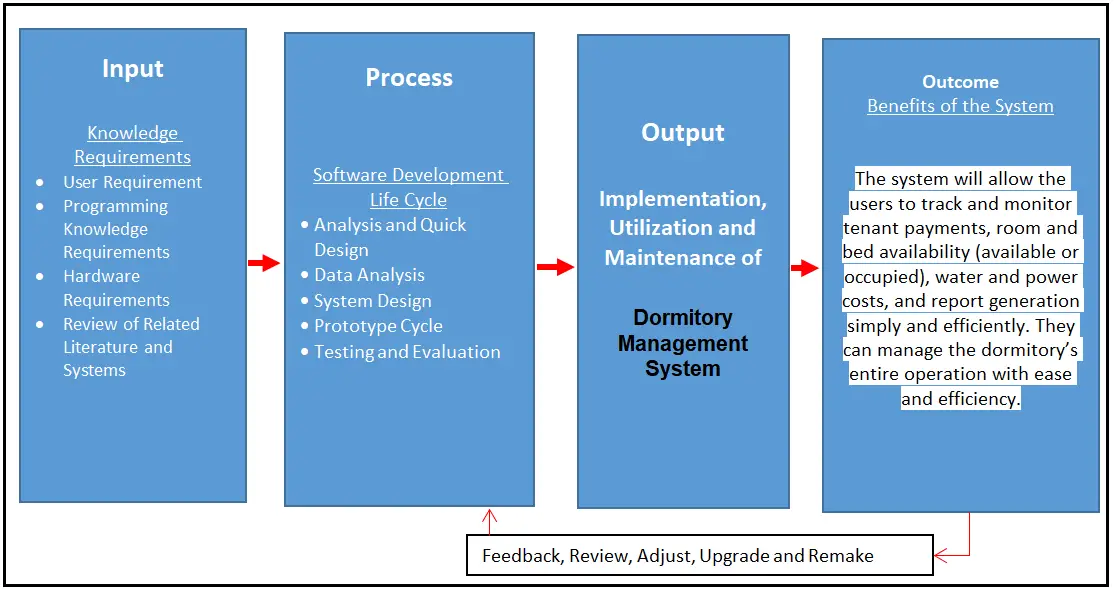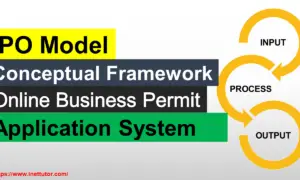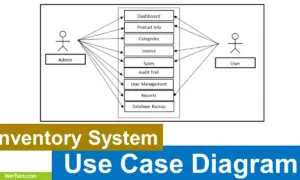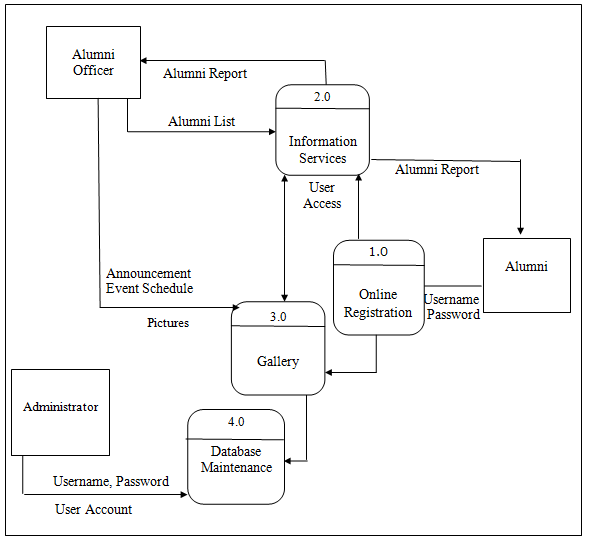IPO Model Conceptual Framework of Dormitory Management System
This post will guide you on how to create a conceptual framework for the project Dormitory Management System using input, process, and output (IPO) model.
What is a Conceptual Framework?
Table of Contents
Researchers utilize a conceptual framework as a tool to help them define and operationalize the important factors in their research. The framework offers a framework within which to place the research question and hypotheses as well as how to arrange the information gathered for the investigation. Additionally, it provides a way for researchers to explain to others how they understand the issue they are researching. When formulating a hypothesis in the early phases of research as well as when analyzing and interpreting data, a conceptual framework can be employed in a variety of contexts. Informing future research choices can also benefit greatly from a conceptual framework.
Input Process Output Model
The Input Process Output model is a framework that has been used in various fields such as business and computer science. It is used to help organizations understand how to take input, process it, and then generate output. The model is also known as the system development life cycle.
Readers are also interested in: Dormitory Management System in PHP and MySQL Capstone Project
About the Project
A dormitory is a place that offers people a space to sleep for how long they pay for it. Dormitories can be boarded by a large number of students or other people. This study was carried out by the researchers to evaluate the current dormitory management methods. The researchers gathered data and discovered that boarding house owners and landladies/landlords face significant obstacles in managing boarding houses efficiently. Monitoring tenant payments, the availability of rooms and beds (available or occupied), water and electricity bills, and much more are all part of dormitory management. Previously, these management areas were manually processed. To manage the aforementioned areas, the majority of dormitories employ a manual approach. The dormitory’s operation will be slowed by manual operation, which will have an impact on the guests’ experience while staying in their rented rooms and beds. The Dormitory Management System project is a web-based system that was designed and developed using PHP, MySQL, and Bootstrap. The dorm owner had ordered that the project be completed to automate the dorm’s transactions.
Objectives of the Study
1. To establish a centralized tenant records management and management reporting system.
2. To make dorms run more smoothly in general.
3. The owner or manager of the dormitory’s workload should be reduced and minimized.
4. To improve the efficiency of the dormitory’s operations and the occupants’ experience while there.
5. To assess the system’s usability, functionality, effectiveness, quality, productivity, and dependability from the perspective of the users.
Readers are also interested in: Dormitory Management System in PHP and MySQL User Interface
Conceptual Framework of Dormitory Management System

The image above is the conceptual framework of the project entitled Dormitory Management System. It is based on IPO model or also known as the input, process and output model.
Input
The input phase or the knowledge requirement stage consists of the following:
User Requirement – The researchers performed an interview with the guidance offices to discover their needs so that the team could create a suitable system that would address their existing problems.
Programming Knowledge – after determining the problems, a solution must be provided and that solution is in a form of information system that will be written in the programming language where the researchers has and adequate knowledge. The researchers will use PHP, MySQL and Bootstrap for the project.
Hardware Requirements – the system cannot work alone without the hardware such as the computer and mobile devices. The researchers had explained it to the user that they need that hardware to fully utilize information system.
Related Literature and Systems – the researchers conducted research on the different literatures and related systems to serve as a guide in the development of the Dormitory Management System.
Readers are also interested in: Boarding House and Dormitory System ER Diagram
Process
Analysis and Quick Design
The researchers conducted a personal interview with the respondents and the chosen client where the study was conducted during Analysis and Quick Design. Respondents were given the opportunity to make suggestions on how the system should be designed. Following data collection, the researchers created an early design for the suggested system.
Data Analysis
All data, user requirements, and information will be analyzed by the researchers. This phase also allows the researchers to get a sense of how to build the system and how the suggested system would benefit the clients.
System Design
The researchers will begin work on the proposed system. It contains the design; how the system would look based on user requirements, and whether or not the researchers/programmers would like to add personal design to make the system more interactive and user pleasant.
Prototype Cycle
During this step, the researchers’ data will be compiled, built, demonstrated, and polished. The researchers begin by developing a prototype based on the desired design and data tables. After it has been built, the prototype will be shown to the client. The researchers show how the system works, the flow of how it works, and the functions of the system’s features. The researchers will next fine-tune the system based on the client’s additional requirements throughout the refining stage. Changes to the feature flow and functionalities will be made in response to user feedback.
Testing and Evaluation
This will contain the feed-back of the planned system after it has been implemented and tested by three experts. It will also notify the researchers and developers if there are any errors, suggestions, or if the system’s functionality will function properly.
This will be a discussion about the implementation of the proposed system, with three (3) experts evaluating it. This will also include whether or not the recommended functions and suggestions are met.
Output
The study’s ultimate output is a Dormitory Management System that will replace the manual operation in managing dormitories. The system’s implementation is strongly encouraged.
The Dormitory Management System is a comprehensive software application that enables universities and colleges to manage their student housing. It provides a centralized database for storing and retrieving student information, and offers a range of features to help improve communication between students and staff.
The system includes a student portal where students can login and view their personal information, including their residency status, course enrolment details, and accommodation assignments. It also allows students to submit requests for information, make complaints, process payments and many more.
The Dormitory Management System has been proven to improve communication between students and staff. It helps to manage student housing efficiently by providing a centralized database and user interface, and by providing access to housing resources. It has also been found to improve student satisfaction with the quality of their accommodation. Overall, the Dormitory Management System is a valuable tool that can help universities and colleges manage their student housing efficiently and improve communication between students and staff.
Outcome
Benefits of the System:
The system will allow the users to track and monitor tenant payments, room and bed availability (available or occupied), water and power costs, and report generation simply and efficiently. They can manage the dormitory’s entire operation with ease and efficiency.
Summary
The goal of this research is to create the conceptual framework for the investigation. The researchers used the IPO model as a foundation for developing the conceptual framework in this study. The first stage is the input phase, which comprises User Requirements, Programming Knowledge Requirements, Hardware Requirements, and a Review of Related Literature and Systems. During the process phase, the researchers will develop the system using the Software Development Life Cycle (SDLC) technique. Analysis and fast design, data analysis, system design, prototype cycle, and testing and evaluation are all components of the SDLC technique. The study’s ultimate goal is to create a Dormitory Management System that will replace manual management of dorms. The implementation of the system is strongly encouraged.
You may visit our Facebook page for more information, inquiries, and comments. Please subscribe also to our YouTube Channel to receive free capstone projects resources and computer programming tutorials.
Hire our team to do the project.


